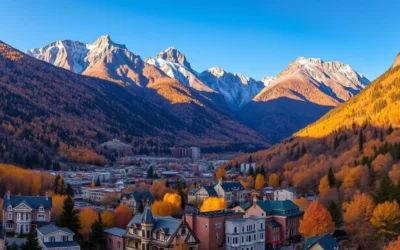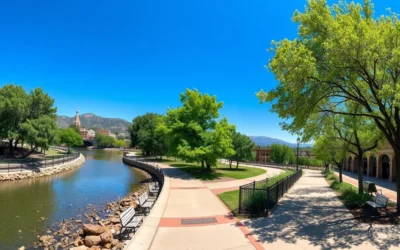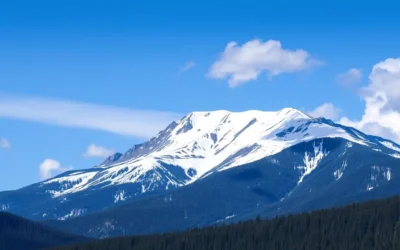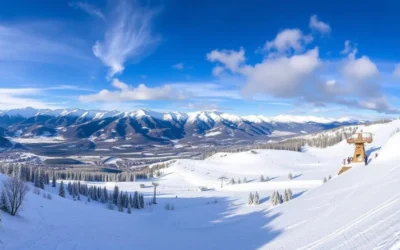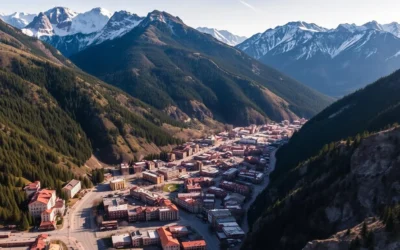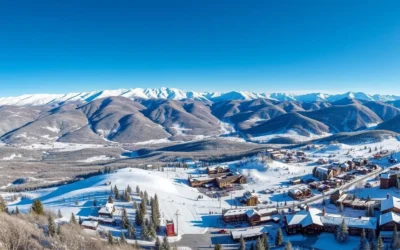✓ Accommodations✓ Flights✓ Rental Cars
Nestled in Summit County, Colorado, Copper Mountain resort boasts an impressive 2,465 acres of skiable terrain, making it a haven for skiing enthusiasts. With a summit elevation of 12,313 feet, the resort offers breathtaking views and challenging slopes that cater to all skill levels.
The terrain at Copper Mountain is naturally segregated, progressing in difficulty from west to east. This unique layout allows skiers to explore a variety of trails, from gentle groomers to advanced terrain parks. Whether you’re a beginner or an expert, Copper Mountain has something for everyone.
As one of Colorado’s premier ski destinations, Copper Mountain is a must-visit. Its diverse terrain, impressive elevation, and natural beauty make it an unforgettable experience. Get ready to explore the highest peaks and mountains within the resort, including Copper Peak and Tucker Mountain.
Overview of Copper Mountain Resort
Copper Mountain Resort is a standout among Colorado’s ski resorts, offering a blend of natural beauty and modern infrastructure. The resort has undergone significant transformations since its inception, making it a must-visit destination for skiers.
Location and Accessibility
Copper Mountain Resort is strategically located in the Rocky Mountains of Colorado, making it easily accessible for both local and international visitors. You can reach the resort via major highways, and it’s also within a reasonable driving distance from Denver International Airport.
The resort’s location within the White River National Forest adds to its natural charm, providing a serene and picturesque skiing experience. With its well-connected infrastructure, you can easily navigate the resort and enjoy its various amenities.
History and Development
The history of Copper Mountain Resort is marked by significant milestones, including changes in ownership and infrastructure development. Initially opened in 1972, the resort has seen several ownership transitions, with Apex Oil Company, Horsham Corporation, Intrawest, and POWDR being key players in its history.
- The Copper Mountain Resort began its journey in November 1972, establishing itself as a premier ski destination in Colorado.
- Over the years, it has undergone several ownership changes, with notable acquisitions by Apex Oil Company in 1980, Horsham Corporation in 1988, Intrawest in 1997, and POWDR in December 2009.
- A significant modernization was the installation of the American Flyer detachable chairlift in 1986, enhancing the resort’s lift infrastructure.
- The opening of Woodward Camp in 2009 marked another significant expansion, providing a 20,000-square-foot indoor ski and snowboard training facility, ready for the new season.
- Becoming an official U.S. Ski Team downhill training venue in the 2011-2012 season further solidified its reputation as a world-class skiing destination.

As you plan your visit to Copper Mountain Resort, you’ll find that its rich history, coupled with its modern amenities, makes for an unforgettable skiing experience. The resort continues to evolve, ensuring that it remains a top choice for skiers of all levels.
Copper Mountain’s Unique Geography
Copper Mountain’s geography is characterized by its unique setting within the White River National Forest. This setting provides a diverse range of terrains and ecosystems, making it an attractive destination for outdoor enthusiasts.
White River National Forest Setting
Copper Mountain is situated within the White River National Forest, one of the largest national forests in the United States. This setting offers a rich environment with varied flora and fauna, enhancing the overall experience for visitors. The forest’s diverse ecosystems contribute to the mountain’s unique geography.

Climate and Weather Patterns
The climate at Copper Mountain is characterized by cold winters and mild summers, typical of the Rocky Mountains. You can expect significant snowfall during the winter months, with the snowiest period usually between December and March. The resort’s north-facing aspect helps preserve snow quality throughout the season.
Annual Snowfall Statistics
Copper Mountain boasts an impressive average annual snowfall of 310 inches, placing it among the snowiest resorts in Colorado’s Summit County. The resort supplements natural snow with snowmaking capabilities covering approximately 380 acres, ensuring reliable early-season conditions. Here’s a breakdown of the snowfall statistics:
| Month | Average Snowfall (inches) |
|---|---|
| December | 45 |
| January | 48 |
| February | 51 |
| March | 46 |
Copper Mountain typically enjoys around 300 days of sunshine annually, creating a perfect combination of abundant snow and clear days. The mountain’s snowmaking capabilities and natural snowfall ensure a long ski season, providing you with plenty of opportunities to enjoy the slopes.
Highest Mountains and Peaks at Copper Mountain
Copper Mountain’s landscape is dominated by towering peaks that attract skiers and snowboarders worldwide. The resort offers a diverse range of mountains and terrain that cater to various skill levels, from beginner to expert.

Summit Elevation and Key Peaks
The summit elevation at Copper Mountain reaches impressive heights, offering breathtaking views and challenging slopes. Key peaks around the resort provide a variety of skiing experiences. The terrain is designed to satisfy both novice and seasoned skiers.
Key Peaks and Their Features
- Multiple peaks offering diverse skiing experiences
- Expert terrain with challenging double black diamond runs
- Scenic views from the summit
Copper Peak
Copper Peak is one of the notable peaks at the resort, offering stunning views and exciting skiing opportunities. While specific details about Copper Peak are not provided, it is recognized as a significant landmark within the Copper Mountain terrain.
Tucker Mountain
Tucker Mountain represents the most extreme terrain at Copper Mountain, featuring expert-only double black diamond runs that challenge even the most accomplished skiers and riders. You can now access Tucker Mountain via the Three Bears lift, a triple chairlift constructed in 2019 that runs from the bottom of Blackjack to the summit. Prior to the installation of the Three Bears lift, this terrain was only accessible by hiking or via a limited weather-permitting snowcat service that operated for a few hours on weekends. The terrain on Tucker Mountain includes steep chutes, cliff bands, and technical tree skiing, providing some of the most challenging in-bounds experiences in Colorado.
Despite being developed with lift access, Tucker Mountain maintains a remote, backcountry feel with minimal grooming and natural features that preserve its raw, challenging character. This makes it an ideal destination for expert skiers seeking an authentic mountain experience.
Copper Mountain, Colorado: Highest Mountains, Peaks, and Terrain Overview
With its naturally segregated terrain, Copper Mountain offers a skiing experience like no other. As you explore the resort, you’ll find that its unique geography provides a diverse range of skiing opportunities, from beginner slopes to challenging expert terrain.

Vertical Drop and Elevation Profile
Copper Mountain boasts an impressive vertical drop of 2,601 feet, with a summit elevation of 12,313 feet and a base elevation of 9,712 feet. This elevation profile provides a thrilling skiing experience, with a variety of trails that cater to different skill levels. The resort’s terrain is carefully managed to ensure that skiers have access to a range of slopes, from gentle groomers to challenging black diamond runs.
Slope Aspects and Exposure
The slope aspects at Copper Mountain vary, providing a mix of sunny and shaded areas. This variation in exposure ensures that skiers can enjoy optimal snow conditions throughout the day. The resort’s terrain is divided into different areas, each with its unique characteristics and challenges.
Comparison to Neighboring Resorts
Copper Mountain distinguishes itself from neighboring resorts like Breckenridge, Keystone, and Arapahoe Basin through its naturally segregated terrain. While these resorts offer extensive village amenities and nightlife, Copper Mountain compensates with its exceptional terrain variety and more authentic mountain experience. You’ll find that Copper offers a less commercialized atmosphere, focusing on the skiing experience rather than luxury amenities. The resort’s location, right off I-70 on your way from Denver, makes it more accessible than some of its competitors during heavy traffic or adverse weather conditions.
In summary, Copper Mountain’s unique blend of high-altitude skiing, varied terrain, and accessible location makes it a standout destination in Colorado. Whether you’re a seasoned skier or just starting out, the resort’s diverse slopes and welcoming atmosphere ensure an unforgettable experience.
Terrain Variety and Trail System
The terrain variety at Copper Mountain is one of its standout features, offering something for every skier. Whether you’re a beginner looking for gentle slopes or an expert seeking challenging descents, Copper Mountain’s trail system has been designed to cater to all abilities.
Natural Terrain Segregation by Ability
Copper Mountain has thoughtfully segregated its terrain to ensure that skiers of all levels can enjoy the mountain without feeling overwhelmed. Beginners can start with gentle trails like Roundabout, accessed via the American Flyer lift, which provides a confidence-building experience with its gentle, winding path and stunning views.
Intermediate skiers will enjoy runs like Andy’s Encore, accessible via the American Eagle lift, known for its perfect pitch and width, making it one of the best intermediate runs on the mountain.
Advanced and expert skiers can challenge themselves on the more demanding terrain, such as Spaulding Bowl, which offers a quintessential Colorado bowl skiing experience with varied terrain and spectacular views of the Ten Mile Range.
Trail Statistics and Distribution
Copper Mountain boasts an impressive trail system, with its longest run, Collage, stretching 1.7 miles (2.73 km) and offering one of the longest continuous descents at the resort. The trails are well-distributed across the mountain, ensuring that there’s always something new to explore.
Signature Runs and Routes
Some of the signature runs at Copper Mountain include Collage, a 1.7-mile long continuous descent perfect for those who enjoy sustained cruising. You’ll also want to experience Andy’s Encore for its intermediate skiing delight. For advanced skiers, Spaulding Bowl is a must, offering varied terrain and spectacular views. Beginners should not miss Roundabout for its gentle, confidence-building experience. Expert skiers will enjoy the challenging descents in the Copper Bowl and Union Bowl areas, such as Cabin Chute and Free Fall.

Advanced and Expert Terrain Features
Copper Mountain offers some of the most challenging terrain in Colorado, catering to advanced and expert skiers. The resort is known for its diverse and demanding slopes, which include bowls, chutes, and cliffs that test even the most experienced skiers.
Bowl Terrain: Copper, Spaulding, Resolution, Jupiter, and Union
The bowl terrain at Copper Mountain is a highlight for many expert skiers. The resort features five distinct bowls: Copper, Spaulding, Resolution, Jupiter, and Union. These bowls offer a range of challenging runs, from steep groomers to complex, rocky terrain. Skiers can enjoy wide-open spaces and varied conditions, making each bowl unique and exciting.
- Copper Bowl offers varied terrain with steep pitches and challenging descents.
- Spaulding Bowl provides a mix of groomed and ungroomed runs.
- Resolution Bowl is known for its steep, technical skiing.
Three Bears and Tucker Mountain Terrain
Tucker Mountain, located at the southern end of the resort, is known for its extreme terrain. It features almost exclusively double black diamond runs, with only one single black diamond run available. The terrain here is steep and technical, demanding precise skiing skills. The Three Bears area also offers challenging runs, though it’s less extreme than Tucker Mountain.

Expert Chutes and Cliffs
For the most adventurous skiers, Copper Mountain’s expert chutes and cliffs represent some of the most challenging in-bounds terrain in Colorado. Concentrated primarily on Tucker Mountain and in the upper portions of the resort’s five bowls, these features demand high levels of skill and confidence. Notable areas include the Copper Bowl, with chutes like Cabin Chute and Free Fall, and the West Ridge area, which offers numerous cliff drops and natural features.
- Cabin Chute and Free Fall in Copper Bowl offer steep, narrow descents.
- The West Ridge area features cliff drops and mandatory air for experienced experts.
These advanced and expert terrain features are typically best accessed mid-season when snow coverage is optimal. Early and late season conditions may expose rocks and other hazards, making it crucial for skiers to assess conditions carefully before attempting these challenging runs.
Lift System and Mountain Access
Copper Mountain’s extensive lift network allows skiers to explore different areas of the mountain efficiently. The resort boasts a range of lifts, including high-speed quads and surface lifts, to cater to various skill levels and preferences.
Key Lifts and Their Terrain
The mountain is serviced by several key lifts, each providing access to unique terrain. The American Flyer and Center Village Gondola are two of the primary lifts, offering a convenient way to reach the upper areas of the mountain. Other notable lifts include the Copper Chair and the Resolution Chair, which serve expert and intermediate terrain, respectively.
| Lift Name | Type | Terrain Served |
|---|---|---|
| American Flyer | High-Speed Quad | Intermediate and Advanced |
| Center Village Gondola | Gondola | Beginner and Intermediate |
| Copper Chair | Chairlift | Expert |
| Resolution Chair | Chairlift | Intermediate |
Recent Lift Upgrades
Copper Mountain has invested in upgrading its lift infrastructure in recent years. These upgrades have improved the overall efficiency and capacity of the lift system, reducing wait times and enhancing the skiing experience. The resort continues to prioritize lift maintenance and upgrades to ensure a seamless experience for visitors.
Navigating the Mountain
Navigating Copper Mountain is relatively straightforward, thanks to its natural terrain segregation and strategic lift placement. However, there are a few quirks to be aware of, such as the need to return to a base area to access certain regions. Safety-bar-mounted trail maps and trail status boards at major junction areas help with orientation, making it easier to plan your day.

Planning Your Visit to Copper Mountain
To make the most of your visit to Copper Mountain, it’s essential to plan ahead. The resort offers a variety of lodging options across its East, Center, and West base villages, ranging from upscale hotels and condos to more family-oriented accommodations.
When deciding on lodging, consider staying near Center Village for convenience. If you’re on a budget, nearby towns like Frisco, Dillon, and Silverthorne offer more affordable options, with free Summit County bus service available to the resort.
The 2024-2025 season is projected to run for approximately 185 days, from November 8, 2024, to May 11, 2025. For the best snow conditions, plan your visit between January and March. Consider purchasing lift tickets in advance or looking into season pass options for the best value.
—
The above is subject to change.
Check back often to TRAVEL.COM for the latest travel tips and deals.

